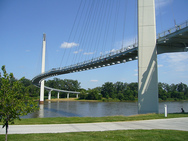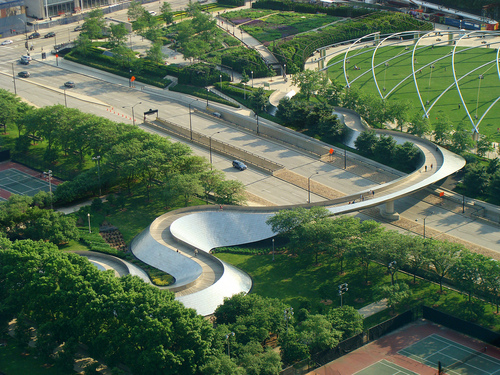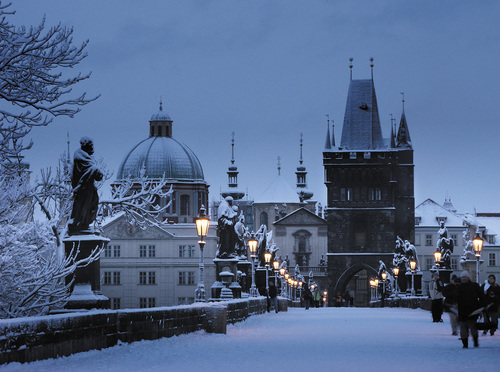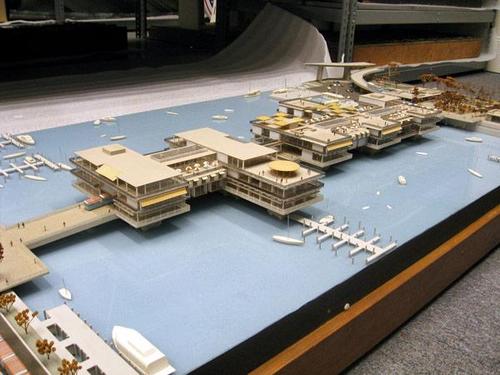An Anacostia footbridge should be more than just a path
David Garber has been calling for a pedestrian bridge across the Anacostia. If DC were to build such a bridge, what should it look like?
The bridges over the Potomac, Anacostia, and Rock Creek are critical connections across the strongest boundaries in DC. The relatively few crossings are the bane of commuters and a significant impediment to the livability of the DC area.
The NCPC NCPC‘s Extending the Legacy Plan suggested a bridge, and a slew of impressive and iconic pedestrian bridges have recently popped up around the United States.
But when planning a bridge, it’s important to consider more than just how the bridge gets people from one side of the river to the other. The structure also needs to function as part of an recreational waterfront, like a public place or a street, including the activities of commerce and relaxation.
Creating a more pleasant route for non-motorized commuters is a good enough end, but for more casual enjoyment, it needs some other qualities. Iconic bridges tend to beautifully express directed motion from one end to another, but not the pauses and distractions of a stroll.
In a way, you create a long pedestrian-only space with no activating buildings. Without a mass of people, those spaces are alienating or unsafe.
Here are some examples that approach the concept differently.
London’s Millennium Bridge is a very successful precedent. It’s on the long end at 1250 feet, but it’s roughly the same size as a Poplar Point Crossing would be. It is part of a pedestrian-only corridor that runs from St. Paul’s Cathedral to the Tate Modern, two of the busiest tourist attractions in the world. You have great views of the City and St. Paul’s, but it’s not very wide and not a great place to linger. This best represents the standard connector bridge.
The foot bridge that joins Chicago’s Millenium Park to Grant Park is more interesting, but less practical. In order to avoid imposing staircases, it runs at a slight incline over a serpentine course. Its relaxed experience of compressions and twists are meant more for casual strolling than a commute, but fits the park setting.
Prague’s Charles Bridge offers both experience and connection. It’s a little longer than the Millenium Bridge, but it’s twice as wide. The space is much more habitable, with vendors hawking touristy schlock on half the space. It has some interesting features, including gateways on either end, refuges, and baroque statues lining the sides. In some ways, it’s much more like a park allée than a bridge, where the inward space of the bridge is emphasized as much as the scenery around it.
There’s also the precedent of putting buildings on a bridge. The Washington Business Journal recently reviewd some of the more famous unbuilt buildings in DC, in advance of an exhibit at the National Building Museum. Included in the accompanying slideshow is a bridge designed by Chloethiel Woodard Smith, based on Florence’s Ponte Vecchio.
The Ponte Vecchio, like Old London Bridge, accrued shops and houses over the years, becoming indistinguishable from any other city street. Smith, an influential architect who designed some of Southwest’s better buildings, proposed this bridge to cross from the Southwest Waterfront to East Potomac Park.
I don’t know whether this would pass a modern environmental analysis, but the opportunity to put restaurants, fountains, or play structures out on the water could emulate the unique atmosphere of a pier, only without the dead end.
Lastly, one alternative would be to build a multi-modal bridge, but make the pedestrian facilities much nicer, with big sidewalks, slow speed limits, or maybe even a sensitive grade separation, like Basel’s Dreirosenbrücke. Or, a solution like Jože Plečnik‘s Triple Bridge could be in order. In a set of three converging bridges, the pedestrian experience is considered primary, but light motoring traffic can use it as well.
These bridges show how it’s worth applying some ingenuity to the development of the waterfront. The iconic bridge only takes a neighborhood so far. There has to be something else there. Maybe the model should start by looking at not only at good bridges, but also good streets that suit both commuting and for strolling.
If you have any other examples of bridges that provide great pedestrian experiences, please suggest them in the comments.
Cross-posted at цarьchitect.






